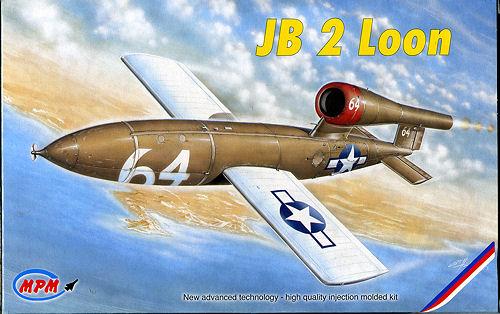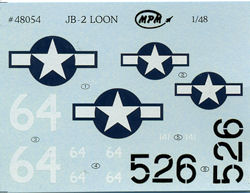
MPM 1/48 JB-2 'Loon'
| KIT: | MPM 1/48 JB-2 'Loon' |
| KIT #: | 48054 |
| PRICE: | $13.70 from GreatModels |
| DECALS: | four options |
| REVIEWER: | Scott Van Aken |
| NOTES: |

| HISTORY |
In July 1944, three weeks after German V-1 "Buzz Bombs" first struck England on June 12th and 13th, American engineers at Wright Field, fired a working copy of the German V-1 pulse-jet engine, "reverse-engineered" from crashed German V-1s that were flown back to the United States from England for analysis. The reverse engineering provided the design of America's first mass-produced guided missile, the JB-2. The Republic Aviation Corp. was to have built the airframe for the JB-2, but sub-contracted the airframe to Willys-Overland. Ford Motor Co built the engine, which was a copy of the V-1's 900-lb. thrust Argus-Schmidt pulse-jet.
The JB -2 was the first unmanned guided missile in America's arsenal. The first launch of a JB-2 took place at Eglin Army Air Field in Florida in October 1944. In addition to the Eglin group, a detachment of the Special Weapons Branch, Wright Field, Ohio, arrived at Wendover Field in Utah in 1944 with the mission of evaluating captured & experimental rocket systems, including the JB-2. Testing was from a launch structure just south of Wendover's Technical Site. The launch area is visible on Google Earth. Parts of crashed V-1s and JB-2s are occasionally found by Wendover Airport personnel.
Contracts were let for production of 2,000 weapons, and Republic and Ford built 1,385 JB-2s for the Army and Navy. Production delivery began in January 1945, but the U.S. Army Air Forces cancelled further production when World War II ended. Just before the end of the war, an aircraft carrier en route to the Pacific took on a load of JB-2s for possible use in the planned invasion of the Japanese home islands.
Although never used in combat, after World War II, the JB-2 played a significant role in the development of more advanced surface-to-surface missile systems.
 The U.S. Army Air Force continued development of the JB-2 as Project MX-544, with two versions: one with preset internal guidance and another with radar control. Several launch platforms were developed, including permanent and portable ramps, and mobile launching from beneath the wings of Boeing B-17G or Boeing B-29 bombers. Testing continued from 1944 to 1946 at Eglin to improve launch and guidance.
The U.S. Army Air Force continued development of the JB-2 as Project MX-544, with two versions: one with preset internal guidance and another with radar control. Several launch platforms were developed, including permanent and portable ramps, and mobile launching from beneath the wings of Boeing B-17G or Boeing B-29 bombers. Testing continued from 1944 to 1946 at Eglin to improve launch and guidance.
The U.S. Navy developed a submarine-launched version, KUW-1 Loon, later called LTV-N-2, which were carried on the aft deck in watertight containers. The first was the SS-348 Cusk which successfully launched its first Loon on February 12, 1947, off Point Mugu, California.
After the United States Air Force became a fully independent arm of the National Military Establishment (later renamed to the Department of Defense) on September 18, 1947, research continued with the development of unmanned aircraft and pilotless bombers, including the already available JB-2 and the sub-sonic, 500 mile range XSSM-A-1 which had been specified in December of 1945. The contract for developing the XSSM-A-1 was awarded to the Glenn L. Martin Company of Baltimore, Maryland and was known as the MX-771 project. The XSSM-A-1 would become the MGM-1 Matador, the U.S. Air Force's first operational missile.
The USAF Air Materiel Command reactivated the JB-2 as Project EO-727-12 on 23 April 1948, at Holloman AFB, New Mexico, the former Alamogordo Army Air Field. The JB-2 was used for development of missile guidance control and seeker systems, testing of telemetering and optical tracking facilities, and as a target for new surface-to-air and air-to-air missiles. The JB-2 project used the North American Aviation NATIV (North American Test Instrument Vehicle) Blockhouse and two launch ramps at Holloman: a 400-ft, two-rail ramp on a 3 degree earth-filled slope, and a 40-ft trailer ramp.
| THE KIT |
 You just cannot get much more simple than this kit. Basically 11 parts. Two for the fuselage and engine halves, four for the wings, two horizontal stabs, two engine intake and a skid. I should also mention that as kitted, this 2003 offering it isn't really a Loon. The biggest area of difference is on the forward engine support. On the Loon, it had a vertical front facing and a long, sloping rear section. Look at the photo above and you'll see what I mean. The kit is more of a Fi-103 (V-1) than a Loon because of this feature. I'm also thinking that the forward part of the engine should be more of a straight cylinder and the kit has it as more conical, tapering back to about half way.
You just cannot get much more simple than this kit. Basically 11 parts. Two for the fuselage and engine halves, four for the wings, two horizontal stabs, two engine intake and a skid. I should also mention that as kitted, this 2003 offering it isn't really a Loon. The biggest area of difference is on the forward engine support. On the Loon, it had a vertical front facing and a long, sloping rear section. Look at the photo above and you'll see what I mean. The kit is more of a Fi-103 (V-1) than a Loon because of this feature. I'm also thinking that the forward part of the engine should be more of a straight cylinder and the kit has it as more conical, tapering back to about half way.
 Detailing on the parts is engraved, though there isn't much detail there. I also noticed some molding flaws on the wings and tailplanes in the form of fine cracks. These can be seen when held to the light or a fingernail run across them. I'm not sure if just paint will fill them so the wise modeler will fill them and sand them down. Fixing the motor mount will be a bit more difficult, but some work with sanding sticks and card stock should provide a more believable shape. Not having some sort of handling dolly also makes displaying it a bit more difficult.
Detailing on the parts is engraved, though there isn't much detail there. I also noticed some molding flaws on the wings and tailplanes in the form of fine cracks. These can be seen when held to the light or a fingernail run across them. I'm not sure if just paint will fill them so the wise modeler will fill them and sand them down. Fixing the motor mount will be a bit more difficult, but some work with sanding sticks and card stock should provide a more believable shape. Not having some sort of handling dolly also makes displaying it a bit more difficult.
Instructions are quite simple and well done. There are markings for four airframes, all basically insignia and in most cases, a number. The difference is in the wide variety of paint schemes. First is the box art scheme in OD with white wings and a red engine intake. Next is an overall OD version with red nose and engine intake. Number three has a red forward section. white center section, wings and tail section with an OD engine and rear central section. Finally, an overall red airframe with a yellow tip to the nose. Decals are very nicely done and should provide no surprises.
| CONCLUSIONS |
There you have it. A very simple kit with great markings that does not precisely make what it purports to be. Doing a V-1 and don't need a handling dolly? Get this kit as the Tamiya one has some engine/pylon issues as well.
| REFERENCES |
March 2008 You can get this and many other fine kits and accessories at GreatModels . If you would like your product reviewed fairly and fairly quickly, please contact the editor or see other details in the Note to Contributors.